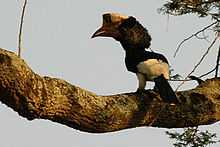Black-and-white-casqued Hornbill
| Black-and-white-casqued Hornbill | |
|---|---|
 | |
| Conservation status | |
| Scientific classification | |
| Kingdom: | Animalia |
| Phylum: | Chordata |
| Class: | Aves |
| Order: | Coraciiformes |
| Family: | Bucerotidae |
| Genus: | Bycanistes |
| Species: | B. subcylindricus |
| Binomial name | |
| Bycanistes subcylindricus (Sclater, 1870) | |
The Black-and-white-casqued Hornbill (Bycanistes subcylindricus) also known as Grey-cheeked Hornbill, is a large, approximately 70 cm long, black and white hornbill. It has an oversized blackish bill with large casque on top. The female is slightly smaller than the male, and has a significantly smaller casque.
The Black-and-white-casqued Hornbill is found in wooded habitats in central and western Africa, ranging from western Kenya to Côte d'Ivoire with an isolated population in north Angola. A monogamous species, pairs nest in suitable tree cavities. The female usually lays up to two eggs. The diet consists mainly of figs, fruits, insects and small animals found in the trees.
Widespread and still locally common, the Black-and-white-casqued Hornbill is evaluated as Least Concern on the IUCN Red List of Threatened Species.[1]
Gallery
References
- ↑ 1.0 1.1 BirdLife International (2012). "Bycanistes subcylindricus". IUCN Red List of Threatened Species. Version 2013.2. International Union for Conservation of Nature. Retrieved 26 November 2013.
External links
| Wikimedia Commons has media related to Bycanistes subcylindricus. |


